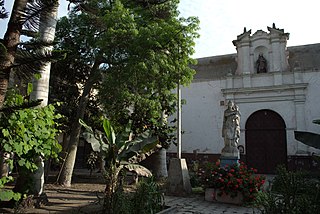
The National University of San Marcos is a public research university located in Lima, the capital of Peru. In the Americas, it is the first officially established and the oldest continuously operating university.

The Lima Metropolitan Area is an area formed by the conurbation of the Peruvian provinces of Lima and Callao. It is the largest of the metropolitan areas of Peru, the seventh largest in the Americas, the fourth largest in Latin America, and among the thirty largest in the world. The conurbation process started to be evident in the 1980s.

La Victoria is one of the forty-three districts that make up the province of Lima, located in Peru. It borders to the north and northeast with the district of Lima, to the east with the district of San Luis, to the southeast with the district of San Borja, to the south with the district of San Isidro, and to the west with the district of Lince and again with the Lima district. La Victoria is a historical and very busy public district located in downtown Lima. The current mayor of La Victoria is Rubén Dioscorides Andrés Cano Altez.

The National Museum of Archaeology, Anthropology, and History of Peru is the largest and oldest museum in Peru, housed at the Palacio de la Magdalena, located in the main square of Pueblo Libre, a district of Lima, Peru. The museum houses more than 100,000 artifacts spanning the entire history of human occupation in what is now Peru. Highlights include the Raimondi Stele and the Tello Obelisk from Chavín de Huantar, and an impressive scale model of the Incan citadel, Machu Picchu. As of 2023, the museum is under restoration and very few rooms are open for visitors.

Metropolitano is a bus rapid transit system serving the city of Lima, Peru. Its construction began in the year 2006.

Liliana del Carmen La Rosa Huertas is a Peruvian nurse and academic specializing in public policy. She was Minister of Development and Social Inclusion of Peru from 2 April 2018 to 11 March 2019, during the government of Martín Vizcarra.

Elizabeth Zulema Tomás Gonzales is a Peruvian cardiovascular anaesthesiologist. She served as the country's Minister of Health from 7 January to 15 November 2019.

Santa Beatriz is a neighbourhood in Lima District. It is the southernmost area of the district. It limits to the north, with the historic centre of Lima; to the east, with La Victoria; to the south, with Lince; and to the west, with Jesús María.

The Royal Hospital of Saint Andrew, originally known as the Hospital of Our Lady of the Conception, was a hospital in the neighbourhood of Barrios Altos, part of the historic centre of Lima, Peru.

Dos de Mayo National Hospital is a public hospital in the neighbourhood of Barrios Altos, part of the historic centre of Lima, Peru. It is considered the first hospital of the republican history of the country, and was preceded by the Royal Hospital of Saint Andrew, itself the oldest hospital of the Viceroyalty of Peru.

Archbishop Loayza National Hospital is a public hospital located in Lima, Peru. It is administered by the Ministry of Health. It was founded by the first archbishop of Peru, Gerónimo de Loayza in 1549 as Saint Anne's Hospital, which provided health services to the indigenous population and poor women. At the beginning of the 20th century, the Charity of Lima began the construction of its current premises on Alfonso Ugarte Avenue.

San Bartolomé Mother–Child National Teaching Hospital is a public teaching hospital that specialises in pediatric and maternal care located in Alfonso Ugarte Avenue, in front of Archbishop Loayza National Hospital, in Lima, Peru. It is administered by the Ministry of Health (MINSA).

The Hospital Civil de la Misericordia, also known as the Hospicio de Insanos or Manicomio del Cercado, was a mental institution that operated in the former Quinta Cortés of the neighbourhood of Barrios Altos, in Lima, Peru, between the years 1859 and 1918. A Civil Guard training school was inaugurated on the former hospital's premises after its closure, which is currently used by the National Police of Peru.

Edgardo Rebagliati Martins National Hospital, formerly known as the Central Hospital of Lima and as the Employee Hospital is a Level IV public hospital in Jesús María District, Lima, Peru. Named after its promoter, Edgardo Rebagliati, it is the most important social security hospital complex in Peru.
The Ministry of the Presidency was a government ministry of the Peruvian government. Created through Law N° 24297 on July 28, 1985, its function was to regulate and coordinate the operation of multisectoral entities and decentralized public organizations of the central government. It was deactivated in 2002.

The Church of Saint Anne is a Catholic church that forms part of the historic centre of Lima, Peru. It is located in Barrios Altos, next to Italy Square, and is one of two main candidates for the location of Rímac, the Indian oracle that gave the local river—and thus the city—its name. For this reason, the site receives the name of Huaca de Santa Ana.

















